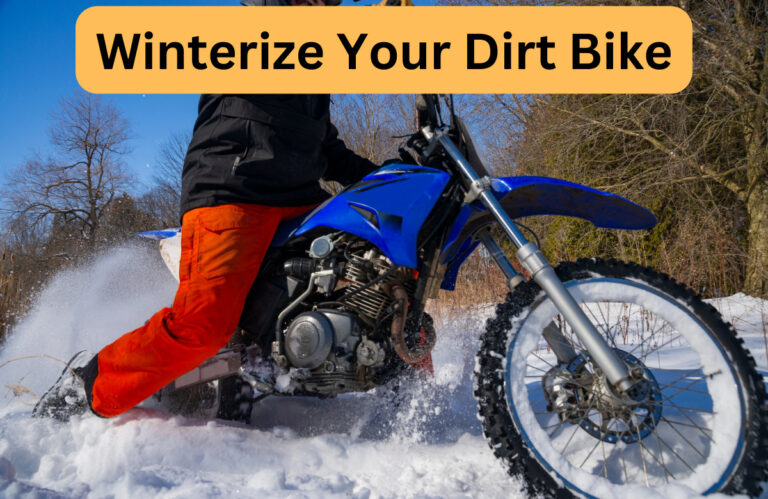How To Ride A Dirt Bike – An In-Depth Examination

You all may know, dirt bikes are off-road motorbikes that are meant to be used on rugged, unpaved terrain. They are designed to tackle a variety of off-road situations such as dirt, mud, sand, and rocky terrain. Unlike ordinary motorbikes, dirt bikes are lightweight, nimble, and have characteristics that allow them to maneuver across difficult terrain. Its function is largely recreational, but it goes beyond that. Off-road racing, trail riding, motocross races, and even professional events are all possible with these motorcycles. They allow riders to enjoy the excitement of high-speed off-road experiences while improving their abilities in dealing with difficult terrain. In the parts that follow, we will go more into the many components of dirt bike riding, such as safety concerns, important gear, and maintenance suggestions. With this, you can make educated judgments and fully appreciate the amazing world of dirt bike by recognizing these characteristics.
The Advantages and Popularity of Dirt Bike
Riding a dirt bike is a wonderful type of exercise that uses the entire body. It increases cardiorespiratory endurance, strength, balance, and coordination. Off-road riding necessitates frequent movement and body modifications, which engage multiple muscle groups and promote overall fitness. Furthermore, the adrenaline rush felt when riding might improve mental well-being and lower stress levels.
Mastering the art of dirt riding necessitates the development of a variety of abilities, including throttle control, balance, cornering, and jumping techniques. Riders must learn to adapt to shifting terrain conditions to retain control and maximum performance. Such obstacles force motorcyclists to constantly develop their riding skills and gain confidence.Dirt bike riding is becoming increasingly popular. It appeals to people of all ages, from toddlers to adults, because it provides a fascinating and demanding leisure activity. More people are adopting this fun and fulfilling activity, thanks to the proliferation of off-road parks, specialized riding paths, and the availability of many dirt bike models.
How to Begin Riding a Dirt Bike – Essential Beginner Tips:
When beginning started with dirt biking, it’s critical to select a bike size and type that is appropriate for your skill level and planned use. Consider your height, weight, and degree of expertise. lesser bikes with lesser engine displacements are often suggested for beginners. While you’re learning the fundamentals, these bikes are easier to manage and control.
Become acquainted with the bike’s controls and features.
Before you ride, acquaint yourself with the bike’s controls and features. This involves learning how to use the throttle, clutch, brakes, gears, and any other controls unique to your bike model. Read the instructions and practice using the controls until you feel competent and comfortable.
Proper bike seating and body alignment.
Maintaining control and stability on a dirt bike requires proper seating and body alignment. For improved balance, sit near the front of the seat and grab the tank with your knees. Keep your elbows high, shoulders relaxed, and your posture neutral. When riding through rocky terrain or approaching jumps, raise your feet on the footpegs. This
Starting the engine and basic motorcycle operation
To begin, make sure the dirt bike is in neutral gear and the kickstand (if applicable) is up. Turn on the ignition, pull in the clutch lever (left handlebar), and aggressively depress the kickstarter lever. In order to avoid stalling, carefully release the clutch once the engine has started. Before riding on more difficult terrain, practice fundamental bike handling skills.
Riding Techniques To practice.
Clutch and throttle control mastery
The clutch and throttle are essential components of dirt bike riding. To engage the engine power smoothly, practice smoothly releasing the clutch while simultaneously applying moderate throttle. This will assist you in your ride.
Effective gear shifting
The majority of dirt motorcycles have manual gearboxes. Familiarize yourself with the placement of the gear shifter and practice shifting gears while riding. When the engine feels fired up, change up to a higher gear, then downshift to a lower bag when you need more power or are approaching bends or obstacles. Shift gears smoothly and without jerking the shifter or moving at inconvenient periods.
Bike balancing and maneuvering at low speeds
Low-speed balance and maneuverability are essential skills for managing tight corners, difficult portions, and obstacles. To maintain balance, practice riding at lower speeds while utilizing the clutch and throttle control. Also ensure constant forward momentum, feather the clutch, and use smooth throttle inputs.
Off-Road Riding Capabilities
For off-road riding capabilities belomentioned are certain considerations.
Riding on trails and off-road tracks:
It is critical to maintain good control and balance when riding on trails and off-road tracks. Maintain stability by keeping your weight centered and using your legs to absorb bumps. Look ahead to see whether there are any forthcoming obstacles or twists. To retain traction, adjust your speed and select the proper gear. Riding on different sorts of terrain will help you enhance your off-road riding skills.
Overcoming barriers (e.g., logs, rocks, jumps):
Overcoming obstacles is an important ability for off-road riding. Approach obstacles quickly enough to go past them, but not so quickly that you lose control. Stand on the footpegs, allowing your legs to function as suspension. Raise the front wheel.
Riding on inclines and descents:
Shift your weight to the rear to retain traction on the rear wheel when riding on inclines. Maintain a constant speed and prevent abrupt bursts of acceleration that might spin the back wheel. Then shift your weight forward on descents to boost grip on the front tire and retain control. To regulate your speed, use both brakes evenly and modulate them. Riding on varied inclines and descents can help you improve your balance and control.
Water crossings and mud pits:
Water crossings and mud pits necessitate precise procedure. Approach water crossings with caution, keeping a steady speed to avoid stalling. To avoid getting your feet wet, stand on the footpegs and keep your feet elevated. Maintain a constant throttle.
Jumping and landing techniques:
Proper jumping technique is required to achieve a smooth takeoff and landing. Approach jumps at a reasonable pace, standing on the footpegs and firmly clutching the bike. Compress the suspension as you approach the leap by bending your knees and leaning back slightly. Shift your weight forward when the front wheel leaves the ground to level the bike. Extend your legs during landing to absorb impact and maintain control. To improve your technique, jump on various types of leaps and landing surfaces.
Advanced Methods to Ride a Dirt Bike
Power slides and wheelies:
Power slides and wheelies demand advanced abilities and should be practiced in a controlled setting. Begin by speeding and then rapidly shifting to produce a wheelie. Jumping and executing stunts need knowledge and experience. Advanced riders can try whips, scrubs, and even backflips. These tricks need a combination of good jumping technique and body and bike control in the air. Start with lesser jumps and work your way up, making sure you have the necessary abilities and safety gear. Seek advice from experienced riders and ride in approved places or on motocross circuits that allow such activity.
Riding on rocky or tricky terrain:
Riding on uneven and rough terrain puts your balance, control, and decision-making abilities to the test. Keep your body loose, allowing your legs and arms to absorb the terrain.
Regular bike maintenance schedule:
Keeping your bike in good condition requires a regular maintenance program. These are mentioned here for your better understanding.
Check tire pressure
- Inspect brakes, including brake pads and cables.
- Check for any loose or worn-out parts.
- Test the functionality of gears and shifters.
Monthly:
- Clean and lubricate the chain.
- Inspect and tighten all bolts and fasteners.
- Check the condition of the tires for wear and tear.
- Inspect the frame for any cracks or damage.
- Check the condition of the cables and housing.
Every 3-6 months
- Replace the brake cables and housing if necessary.
- Replace the gear cables and housing if necessary.
- Inspect and replace the brake pads if worn out.
- Check the condition of the chain and cassette.
- Check and adjust the headset and bottom bracket.
Conclusion:
Finally, riding a dirt bike is an exciting and demanding activity that stimulates both the body and the mind. It has various advantages, including greater fitness, coordination, and stress reduction. To get started with dirt riding, select the appropriate bike size and type based on your ability level and planned use. Familiarize yourself with the bike’s controls and functions, as well as correct seating and body alignment, and learn the fundamentals of motorcycle operation. It is critical to practice skills such as clutch and throttle control, effective gear shifting, and bike balancing at moderate speeds in order to ride safely and enjoyably. As you continue, you will be able to experience off-road riding talents such as trail handling, overcoming obstacles, riding on inclines and descents, managing water crossings and mud pits, and so on. With these guidelines, you can embark on an exciting journey in the world of dirt biking.







